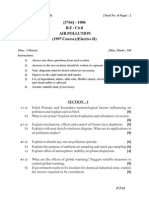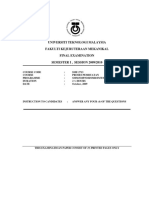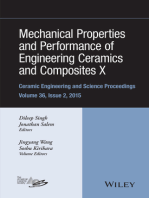Semester 1 Examinations 2018/2019: Programme (S)
Semester 1 Examinations 2018/2019: Programme (S)
Uploaded by
fuckoffmanOriginal Description:
Original Title
Copyright
Available Formats
Share this document
Did you find this document useful?
Is this content inappropriate?
Report this DocumentCopyright:
Available Formats
Semester 1 Examinations 2018/2019: Programme (S)
Semester 1 Examinations 2018/2019: Programme (S)
Uploaded by
fuckoffmanCopyright:
Available Formats
SEMESTER 1 EXAMINATIONS 2018/2019
MODULE: MM409 - Adv Eng Materials & Manufacturing Processes
PROGRAMME(S):
CAM B.Eng. Mechanical & Manufacturing Eng
MWB BSc Manufacturing Eng with Business
YEAR OF STUDY: 4
EXAMINER(S):
Nicholas Dunne (Internal) (Ext: 5712)
Dr. Gerard Ryder (External) External
Prof. David Kennedy (External) External
TIME ALLOWED: 2 Hours
INSTRUCTIONS: Answer 4 questions. All questions carry equal marks.
PLEASE DO NOT TURN OVER THIS PAGE UNTIL YOU ARE INSTRUCTED TO DO SO.
The use of programmable or text storing calculators is expressly forbidden.
Please note that where a candidate answers more than the required number of questions, the
examiner will mark all questions attempted and then select the highest scoring ones.
Requirements for this paper:
1. Statistical Tables
MM409 – Adv Eng Materials and Manufacturing Processes
Semester 1 Examinations 2018/2019 Page 1 of 7
QUESTION 1 [TOTAL MARKS: 25]
Q 1(a) [8 Marks]
Briefly describe four advantages and four disadvantages of advanced composite
materials.
Q 1(b) [4 Marks]
Outline the four fibre factors that contribute to the mechanical performance of
advanced composite materials.
Q 1(c) [4 Marks]
Briefly describe the four principal roles of the matrix in an advanced composite
material.
Q 1(d) [9 Marks]
Calculate the surface/volume ratio for a cylindrical reinforcement for a range of values
of the ratio of radius to length r/l. Show that the surface/volume ratio is greatest when
r/l is either very small or very large. What does this suggest about the most efficient
types of reinforcement?
[End of Question 1]
QUESTION 2 [TOTAL MARKS: 25]
Q 2(a) [12 Marks]
Using an annotated diagram, describe the ultrasonic welding process. Also include in
your answer two advantages, two disadvantages and outline three applications where
the process of ultrasonic welding is applied.
Q 2(b) [6 Marks]
A 15 mm thick lap joint was produced by joining two sheets of Nylon using ultrasonic
welding. The ultrasonic welding process operated at a frequency of 20 Hz for 4
seconds. Calculate the minimum electrical energy produced during the welding. Note
the Vickers hardness is approximately three times the ultimate tensile strength. Use
ultimate tensile strength of Nylon = 68 MPa and k = 1.82 x10-7.
MM409 – Adv Eng Materials and Manufacturing Processes
Semester 1 Examinations 2018/2019 Page 2 of 7
Q 2(c) [3 Marks]
Briefly describe how an oxide layer affects the quality of a weld if not removed.
Q 2(d) [4 Marks]
Briefly outline four of the main defects associated with using an improper welding
procedure.
[End of Question 2]
QUESTION 3 [TOTAL MARKS: 25]
Q 3(a) [9 Marks]
Zirconium dioxide is a ceramic based material that is used in sensor technology to
detect oxygen. Using annotated diagrams, briefly explain the principle, approach and
operation of zirconia dioxide as an oxygen sensor.
Q 3(b) [6 Marks]
A large particle composite consisting of tungsten particles within a copper matrix is to
be prepared. If the volume fractions of copper and tungsten are 0.80 and 0.20,
respectively, calculate the maximum specific strength of this composite given the data
in the table below (Table Q3.1.).
Table Q3.1.
MATERIAL SPECIFIC GRAVITY TENSILE STRENGTH (MPa) MODULUS (GPa)
Copper 8.90 200 110
Tungsten 19.30 425 400
Q 3(c) [10 Marks]
Cemented carbides are classified as a type of metal matrix composite because the
metallic binder is the matrix that holds the bulk material (i.e. carbide ceramic particles)
together. Using annotated diagrams, describe in detail the manufacturing route for
cemented carbide components. In your answer, also make reference to the sintering
process and possible secondary operations.
[End of Question 3]
MM409 – Adv Eng Materials and Manufacturing Processes
Semester 1 Examinations 2018/2019 Page 3 of 7
QUESTION 4 [TOTAL MARKS: 25]
Q 4(a) [3 Marks]
Increases in chain stiffness within a polymer structure can increase the melting and
glass transition temperatures. Briefly, list the three main grouping arrangements
responsible for increasing chain stiffness.
Q 4(b) [6 Marks]
Considering your answer from Q 4(a). Sketch a graph showing the relationship
between specific volume (y-axis) versus temperature (x-axis) for glass, semi-
crystalline solid and crystalline solid polymers. On the graph indicate the melting and
glass transition temperatures for the aforementioned polymer systems.
Q 4(c) [7 Marks]
An example of an advanced polymer material is ultra-high molecular weight
polyethylene (UHMWPE). Briefly outline four of the key features and three main
applications of UHMWPE.
Q 4(d) [9 Marks]
A polymer with viscosity 250 N.s/m2 is to be extruded using a screw extruder, with
details as follows: Diameter of barrel D = 100 mm, screw speed, N = 60 rev/min, screw
helix angle = φ = 15°. The metering zone has: length L = 350 mm, and flight depth H
= 3 mm.
(i) Calculate the volumetric flow rate of the polymer if the screw were operated
under open discharge conditions.
(ii) Calculate the maximum pressure that can be generated in the event of a
blockage at the die.
[End of Question 4]
MM409 – Adv Eng Materials and Manufacturing Processes
Semester 1 Examinations 2018/2019 Page 4 of 7
QUESTION 5 [TOTAL MARKS: 25]
Q 5(a) [10 Marks]
Using an annotated sketch, briefly describe the continuous ingot casting process. In
your answer indicate two advantages and four disadvantages of the process.
Q 5(b) [6 Marks]
Briefly describe the single crystal casting process. In your answer indicate the main
advantage and two applications of the process.
Q 5(c) [9 Marks]
Fluxes are regularly used during various casting process. Describe the compound
type, principal role and four of secondary functions of fluxes and give examples of
three typical compounds used.
[End of Question 5]
QUESTION 6 [TOTAL MARKS: 25]
Q 6(a) [12 Marks]
Electromagnetic Forming Ltd wish to reduce the amount of electrical power that they
use in the electromagnetic forming process. In order to do this they devised the design
of experiments shown in Table Q6.1. The three processing parameters varied were
the diameter of the sheet formed (parameter A), the distance between the sheet metal
and the forming coil (parameter B) and the thickness of the formed sheet metal
(parameter C). A high and low level of each of these parameters was examined in a
23 factorial design. The resulting values of power recorded from these experiments
are shown in Table Q6.1. Quantitatively determine and then describe the influence of
the three parameters on the power consumed.
MM409 – Adv Eng Materials and Manufacturing Processes
Semester 1 Examinations 2018/2019 Page 5 of 7
Table Q6.1.
Power
Experiment A B C
(W)
1 - - - 120
2 + - - 110
3 - + - 105
4 + + - 100
5 - - + 90
6 + - + 50
7 - + + 95
8 + + + 55
Q 6(b) [8 Marks]
Figure Q6.1. shows different responses for y as a function of x1 and x2. With this in
mind, for each case, briefly describe the extent of the effects of x1 and x2 on y and if
any interaction is occurring between x1 and x2.
Figure Q6.1.
MM409 – Adv Eng Materials and Manufacturing Processes
Semester 1 Examinations 2018/2019 Page 6 of 7
Q 6(c) [5 Marks]
Describe the simplest and most common type of factorial design. What is the main
disadvantage associated with this type of factorial design, and a process used to
reduce the extent of this disadvantage?
[End of Question 6]
[END OF EXAM]
MM409 – Adv Eng Materials and Manufacturing Processes
Semester 1 Examinations 2018/2019 Page 7 of 7
You might also like
- Outcomes Beginner Teachers BookDocument234 pagesOutcomes Beginner Teachers BookМаша Каплун100% (1)
- Emotional Maturity ScaleDocument4 pagesEmotional Maturity ScaleKumar Kambri100% (3)
- 05may P2 ME2103 Materials Eng and ManufactureDocument6 pages05may P2 ME2103 Materials Eng and ManufactureW GangenathNo ratings yet
- me212TEST2 2014 2015A-1-1Document12 pagesme212TEST2 2014 2015A-1-1Yohanis BonifaceNo ratings yet
- Mech3002y 3 2009 2 PDFDocument5 pagesMech3002y 3 2009 2 PDFKeshav GopaulNo ratings yet
- Mech3002y 3 2011 2 PDFDocument5 pagesMech3002y 3 2011 2 PDFKeshav GopaulNo ratings yet
- 1516 DecDocument14 pages1516 DecMohamad Yusuf HelmiNo ratings yet
- Engineering Materials: Properties and Selection Module: ME1103Document7 pagesEngineering Materials: Properties and Selection Module: ME1103Moses Daniels-OsasNo ratings yet
- Quality Management: Department of Mechanical Engineering, MNIT JaipurDocument6 pagesQuality Management: Department of Mechanical Engineering, MNIT JaipurAnonymous SinghNo ratings yet
- EG-284 Manufacturing Technology II Level 2: Prifysgol Abertawe Swansea University School of EngineeringDocument3 pagesEG-284 Manufacturing Technology II Level 2: Prifysgol Abertawe Swansea University School of EngineeringVittor BenineNo ratings yet
- Mech3002y 3 2007 2 PDFDocument6 pagesMech3002y 3 2007 2 PDFKeshav GopaulNo ratings yet
- Module Code PRDT01C04Document9 pagesModule Code PRDT01C04Sherif El-soudyNo ratings yet
- Aluminium Based Metal Matrix Composites For Aerospace Application: A Literature ReviewDocument6 pagesAluminium Based Metal Matrix Composites For Aerospace Application: A Literature ReviewIOSRjournalNo ratings yet
- Advanced Welding Technology EME022Document2 pagesAdvanced Welding Technology EME022Ratan Pal Singh YadavNo ratings yet
- SEMESTER 2 SESI 2016/2017: Lecturer: Lillian GungatDocument22 pagesSEMESTER 2 SESI 2016/2017: Lecturer: Lillian GungatAerron JoshuaNo ratings yet
- Mech3002y 3 2010 2 PDFDocument5 pagesMech3002y 3 2010 2 PDFKeshav GopaulNo ratings yet
- University of MauritiusDocument8 pagesUniversity of MauritiusKeshav GopaulNo ratings yet
- Exam Comp 2022Document6 pagesExam Comp 2022Bashar AlfadliNo ratings yet
- 20me53it Amt June July 2023Document29 pages20me53it Amt June July 2023bharathrajgowda203100% (1)
- Friction Stir Welding PP TDocument56 pagesFriction Stir Welding PP TSantosh V HiremathNo ratings yet
- QM ZG536 Ec-2r First Sem 2023-2024Document2 pagesQM ZG536 Ec-2r First Sem 2023-2024siranjivikumar.m1No ratings yet
- UofG Civil Engineering 1 201912Document6 pagesUofG Civil Engineering 1 201912dinalamin195No ratings yet
- Sept 14 Engineering MaterialsDocument12 pagesSept 14 Engineering MaterialsShamni KarthegesuNo ratings yet
- Be Paper 1Document852 pagesBe Paper 1Vishal Gaurav100% (2)
- PRODUCTIONTECHNOLOGYDocument4 pagesPRODUCTIONTECHNOLOGYSamiullah MohammedNo ratings yet
- Sin Cos Cos Sin Cos Sin Cos Sin 2 Cos Sin Cos Sin 2 Sin Cos) (TDocument6 pagesSin Cos Cos Sin Cos Sin Cos Sin 2 Cos Sin Cos Sin 2 Sin Cos) (TBernice JohnsonNo ratings yet
- Engineering Chemistry - I: Page 1 of 2Document5 pagesEngineering Chemistry - I: Page 1 of 2sanyasirao1No ratings yet
- TCL 3102 Microwave Devices QDocument4 pagesTCL 3102 Microwave Devices QElisha NdhlovuNo ratings yet
- Advanced Manufacturing ProcessDocument2 pagesAdvanced Manufacturing Processmukesh3021No ratings yet
- University of Mauritius: Special Retake ExaminationsDocument6 pagesUniversity of Mauritius: Special Retake ExaminationsKeshav GopaulNo ratings yet
- Final Examination SEMESTER I, SESSION2014/2015Document13 pagesFinal Examination SEMESTER I, SESSION2014/2015Mohamad Yusuf HelmiNo ratings yet
- University College LondonDocument3 pagesUniversity College LondonSteven LauNo ratings yet
- 127JH052019Document2 pages127JH052019Mohan ReddyNo ratings yet
- Safety 2016-17Document6 pagesSafety 2016-17SKITTLE BEASTNo ratings yet
- Cege 0011Document7 pagesCege 0011Sarah SmithNo ratings yet
- Engineering Chemistry - II JwfilesDocument4 pagesEngineering Chemistry - II JwfilesasjhdkajNo ratings yet
- RR 410309 Unconventional Machining ProcessesDocument4 pagesRR 410309 Unconventional Machining ProcessesSRINIVASA RAO GANTANo ratings yet
- University of Mauritius University of Mauritius University of Mauritius University of MauritiusDocument4 pagesUniversity of Mauritius University of Mauritius University of Mauritius University of MauritiusPriyam RamsokulNo ratings yet
- JntuK CAD/CAM Question PaperDocument4 pagesJntuK CAD/CAM Question PaperANILKUMAR KONDANo ratings yet
- MM312 Final Exam Paper - 2020Document6 pagesMM312 Final Exam Paper - 2020Praveet ChandNo ratings yet
- Mech3002y 3 2015 2Document7 pagesMech3002y 3 2015 2Keshav GopaulNo ratings yet
- (3832) - 302 M. Sc. (Applied) Petroleum Technology PT - 10: Formation Evaluation - I (New Syllabus) (Sem. - III)Document20 pages(3832) - 302 M. Sc. (Applied) Petroleum Technology PT - 10: Formation Evaluation - I (New Syllabus) (Sem. - III)Mufaddal KabuliwalaNo ratings yet
- EG284 Exam Paper June 2008Document3 pagesEG284 Exam Paper June 2008Vittor BenineNo ratings yet
- B.E. PaersDocument711 pagesB.E. PaersSameer ShaikhNo ratings yet
- Mock Exam 22 23 KH6063MAA - Computational - ThermoFluids - 2022 2023Document6 pagesMock Exam 22 23 KH6063MAA - Computational - ThermoFluids - 2022 2023Mohamed SaadNo ratings yet
- Ucm Anna Univ Question PapersDocument24 pagesUcm Anna Univ Question PapersNarayanan SubramanianNo ratings yet
- EIM212 16 EIM212Nov2013Document6 pagesEIM212 16 EIM212Nov2013Priviledge MuzotaNo ratings yet
- Cven2302 Final Exam 2011Document4 pagesCven2302 Final Exam 2011Latasha SteeleNo ratings yet
- Em MiDocument2 pagesEm MisathishskymechNo ratings yet
- FSW Welding PresentationDocument56 pagesFSW Welding PresentationMazharNo ratings yet
- Safety 2017-18Document9 pagesSafety 2017-18SKITTLE BEASTNo ratings yet
- MG103 2017 11 PDFDocument9 pagesMG103 2017 11 PDFTamiranashe Tammie NyunguNo ratings yet
- Advanced Manufacturing ProcessDocument2 pagesAdvanced Manufacturing Processmukesh3021No ratings yet
- BE 2012 Course in Semester Examination (409351) : Total No of Questions: (06) Seat No.Document1 pageBE 2012 Course in Semester Examination (409351) : Total No of Questions: (06) Seat No.Shrikant S. BarkadeNo ratings yet
- 0809 July PDFDocument9 pages0809 July PDFShah MalikNo ratings yet
- Mechanical Properties and Performance of Engineering Ceramics and Composites X: A Collection of Papers Presented at the 39th International Conference on Advanced Ceramics and CompositesFrom EverandMechanical Properties and Performance of Engineering Ceramics and Composites X: A Collection of Papers Presented at the 39th International Conference on Advanced Ceramics and CompositesDileep SinghNo ratings yet
- Advanced Processing and Manufacturing Technologies for Nanostructured and Multifunctional Materials IIFrom EverandAdvanced Processing and Manufacturing Technologies for Nanostructured and Multifunctional Materials IITatsuki OhjiNo ratings yet
- Ceramic Materials for Energy Applications V: A Collection of Papers Presented at the 39th International Conference on Advanced Ceramics and CompositesFrom EverandCeramic Materials for Energy Applications V: A Collection of Papers Presented at the 39th International Conference on Advanced Ceramics and CompositesJosef MatyášNo ratings yet
- Dynamic Damage and FragmentationFrom EverandDynamic Damage and FragmentationDavid Edward LambertNo ratings yet
- Advances in Ceramic Armor XIFrom EverandAdvances in Ceramic Armor XIJerry C. LaSalviaNo ratings yet
- Sustainable Steel Buildings: A Practical Guide for Structures and EnvelopesFrom EverandSustainable Steel Buildings: A Practical Guide for Structures and EnvelopesBernhard HaukeNo ratings yet
- Semester 1 Examinations 2018/2019: Programme (S)Document17 pagesSemester 1 Examinations 2018/2019: Programme (S)fuckoffmanNo ratings yet
- Semester 1 Examinations 2018/2019: Programme (S)Document5 pagesSemester 1 Examinations 2018/2019: Programme (S)fuckoffmanNo ratings yet
- Semester 1 Examinations 2015/2016: Dublin City UniversityDocument8 pagesSemester 1 Examinations 2015/2016: Dublin City UniversityfuckoffmanNo ratings yet
- Semester 1 Examinations 2018/2019: Programme (S)Document6 pagesSemester 1 Examinations 2018/2019: Programme (S)fuckoffmanNo ratings yet
- DEPED PFA Module 2 Self GuidedDocument3 pagesDEPED PFA Module 2 Self GuidedLrac Sirad TrinidadNo ratings yet
- Jane ReflexologyDocument17 pagesJane ReflexologyDobre CristinaNo ratings yet
- Inside Listening and Speaking 2 Transcripts Unit 1 Solving A Mystery EngineeringDocument4 pagesInside Listening and Speaking 2 Transcripts Unit 1 Solving A Mystery Engineeringhồng quân trươngNo ratings yet
- Maths-Class-Xii-Sample-Paper-Test-13-For-Board-Exam-2024-Answers (1) For BoardsDocument15 pagesMaths-Class-Xii-Sample-Paper-Test-13-For-Board-Exam-2024-Answers (1) For Boardsaryansharma1523visNo ratings yet
- Impact of Epoxy Grouting in Tile Works: Sr. No. Description No. Length Width Qty RemarksDocument1 pageImpact of Epoxy Grouting in Tile Works: Sr. No. Description No. Length Width Qty RemarksabhinavparmarNo ratings yet
- Process Design: Types and CharacteristicsDocument44 pagesProcess Design: Types and CharacteristicsHARSHIT SINGHNo ratings yet
- Maths Coordinate GeometryDocument5 pagesMaths Coordinate GeometryMuhammad MustafaNo ratings yet
- Reflection For CriminologyDocument9 pagesReflection For CriminologyChen-chen EnocNo ratings yet
- Agrochemicals and Their Impact On Human HealthDocument50 pagesAgrochemicals and Their Impact On Human HealthMuthamil BharathiNo ratings yet
- 001 Influences - On - Measuring - ResultsDocument1 page001 Influences - On - Measuring - ResultsThamizhmani VNo ratings yet
- Onyx ESD Supplemental DatasheetDocument3 pagesOnyx ESD Supplemental DatasheetAntonio BermudezNo ratings yet
- Famous Scientist Research ProjectDocument2 pagesFamous Scientist Research ProjectGABRIELA HERNANDEZ MORANo ratings yet
- Theories of Social Change: Diana LeatDocument16 pagesTheories of Social Change: Diana Leateldad.shahar1592No ratings yet
- Endress-Hauser Proline Promass F 200 8F2B PTDocument11 pagesEndress-Hauser Proline Promass F 200 8F2B PTDAYMA INSTALAÇOESNo ratings yet
- 4.1 Strategic Management ProcessDocument58 pages4.1 Strategic Management Processrohit pandeyNo ratings yet
- Damidil 9117 - SDSDocument8 pagesDamidil 9117 - SDSSaba AhmedNo ratings yet
- Importing Necessary LibrariesDocument29 pagesImporting Necessary LibrariesMazhar MahadzirNo ratings yet
- Science-4-Lp Safety Precaution Durin Gdifferent Weather Condition (7e's)Document10 pagesScience-4-Lp Safety Precaution Durin Gdifferent Weather Condition (7e's)Jazmin Ante100% (1)
- Ebe 3113 Concrete & Timber Technology IDocument3 pagesEbe 3113 Concrete & Timber Technology IDante MutzNo ratings yet
- Final ExamDocument4 pagesFinal ExamJane LuNo ratings yet
- Agro-Climatology: Semester 2 Credit 2 - 1Document16 pagesAgro-Climatology: Semester 2 Credit 2 - 1Tata MartaNo ratings yet
- Time, Speed & Distance (Model Based)Document6 pagesTime, Speed & Distance (Model Based)Preetham SurepallyNo ratings yet
- Case Study - 2Document5 pagesCase Study - 2Aparna GuptaNo ratings yet
- Heavy Maintenance Reference Guide PDFDocument35 pagesHeavy Maintenance Reference Guide PDFMedhin HailuNo ratings yet
- Bernard Williams: A Critique of Utilitarianism: Phil 240, Introduction To Ethical Theory, W6L4 Benjamin Visscher Hole IVDocument28 pagesBernard Williams: A Critique of Utilitarianism: Phil 240, Introduction To Ethical Theory, W6L4 Benjamin Visscher Hole IVYasir Ahmed SiddiquiNo ratings yet
- 27-Soil Surveys For Highway ConstructionDocument27 pages27-Soil Surveys For Highway Constructionmanhal alnoaimy100% (1)
- Experiences of Voluntary Early Participation in Environmental Impact Assessments in Chilean MiningDocument11 pagesExperiences of Voluntary Early Participation in Environmental Impact Assessments in Chilean Miningluis miguelNo ratings yet
- Key To SchaereriaDocument8 pagesKey To SchaereriaGabriel Felipe PenalozaNo ratings yet





























































































